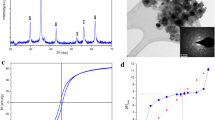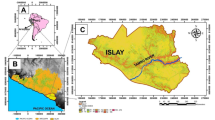Abstract
Introduction
Arsenic is a well known water contaminant that causes toxicological and carcinogenic effects. In this work magnetite nanoparticles were examined as possible arsenic sorbents. The objective of this work was to develop a sorption kinetics model, which could be used to predict the amount of arsenic adsorbed by magnetite nanoparticles in the presence of naturally occurring species using a first-order rate equation, modified to include adsorption, described by a Langmuir isotherm.
Discussion
Arsenate and arsenite adsorption to magnetite nanoparticles was studied, including the effect of naturally occurring species (sulfate, silica, calcium magnesium, dissolved organic matter, bicarbonate, iron, and phosphate) on adsorption.
Conclusion
The model accurately predicts adsorption to magnetite nanoparticles used in a batch process to remove arsenic from spiked Houston, TX tap water, and contaminated Brownsville, TX groundwater.



Similar content being viewed by others
References
Anderson LCD, Bruland KW (1991) Biogeochemistry of arsenic in natural waters: the importance of methylated species. Environ Sci Technol 25:420–427
Appelo CA, Van Der Weiden MJJ, Tournassat C, Charlet L (2002) Surface complexation of ferrous iron and carbonate on ferrihydrite and the mobilization of arsenic. Environ Sci Technol 36:3096–3103
Arai Y, Sparks DL, Davis JA (2004) Effects of dissolved carbonate on arsenate adsorption and surface speciation at the hematite–water interface. Environ Sci Technol 38:817–824
Banfield JF, Navrotsky A (2003) Nanoparticles and the environment. Reviews in mineralogy and geochemistry. Geochim Cosmochim Acta 67:1753
Coker VS, Gault AG, Pearce CI, Vanderlann G, Telling ND, Charnock JM, Polya DA, Lloyd JR (2006) XAS and XMCD evidence for species-dependent partitioning of arsenic during microbial reduction of ferrihydrite to magnetite. Environ Sci Technol 40:7745–7750
Cornell RM, Schwertmann U (1996) The iron oxides: structure, properties, reactions, occurrence and use. Weinheim, New York 573 pp
Dayong S, Wang Y, Guo Y, Wang J, Zhou H, Zhou Y-H, Li Z-S, JP F (2008) Mechanism of CYP2C9 inhibition by flavones and flavonols. Drug Metab Dispos 37:629–634
Dixit S, Hering JG (2003) Comparison of arsenic(V) and arsenic (III) sorption onton iron oxide minerals: implications for arsenic mobility. Environ Sci Technol 37:4182–4189
Dzombak DA, Morel FM (1990) Surface complexation modeling: hydrous ferric oxide. Wiley, New York
Frankenberger WT (ed) (2002) Environmental chemistry of arsenic. Soils, plants, and the environment. Marcel Dekker, New York, 391 pp
Genc H, Tjell JC (2003) Effects of phosphate, silicate, sulphate, and bicarbonate on arsenate removal using activated seawater neutralized red mud. J Phys IV France 107:537–540
Gimenez J, Martınez M, Jd P, Rovira M, Duroc L (2007) Arsenic sorption onto natural hematite, magnetite, and goethite. J Hazard Mater 141:575–580
Grafe M, Eick M, Grossl P, Saunders A (2002) Adsorption of arsenate and arsenite on ferrihydrite in the presence and absence of dissolved organic matter. J Environ Qual 31:1115–1123
HACH (2007) HACH water analysis handbook procedures. HACH, Loveland
Hering JG, Chen P-Y, Wilkie JA, Elimelech M (1997) Arsenic removal from drinking water during coagulation. J Environ Eng 123:800–807
Hongshao Z, Stanforth R (2001) Competitive adsorption of phosphate and arsenate on goethite. Environ Sci Technol 35:4753–4757
Jain A, Loeppert RH (2000) Effect of competiting anions on the adsorption of arsenate and arsenite by ferrihydrite. J Environ Qual 29:1423–1430
Jenne EA (1979) Chemical modeling in aqueous systems. ACS Symposium. American Chemical Society, Washington
Kanel SR, Manning B, Charlet L, Choi H (2005) Removal of Arsenic(III) from groundwater by nanoscale zero-valent iron. Environ Sci Technol 39:1291–1298
Krupka RM (1983) The kinetics of transport inhibition by noncompetitive inhibitors. J Membr Biol 74:175–182
Meng X, Bang S, Korfiatis GP (2000) Effects of silicate, sulfate, and carbonate on arsenic removal by ferric chloride. Water Res 34:1255–1261
O’Day PA, Vlassopoulous D, Meng X, Benning LG (ed) (2005) Advances in arsenic research. ACS Symposium. Oxford University Press, USA, 433 pp
Ohe K, Tagai Y, Nakamura S, Oshima T, Baba Y (2005) Adsorption behavior of As(III) and As(V) using magnetite. J Chem Eng Jpn 38:671–676
Pierce ML, Moore CB (1982) Adsorption of arsenite and arsenate on amorphous iron hydroxide. Water Res 16:1247
Raven KP, Jain A, Loeppert RH (1998) Arsenite and arsenate adsorption on ferrihydrite: kinetics, equilibrium, and adsorption envelopes. Environ Sci Technol 32:344
Rusanov AI (2005) Surface thermodynamics revisited. Surf Sci Rep 58:111
Shipley HJ (2007) Magnetite nanoparticles for removal of arsenic from drinking water. Rice University, Houston, 147 pp
Shipley HJ, Yean S, Kan AT, Tomson MB (2009) Effect of solid concentration, pH, IS, and temperature on arsenic adsorption. Environ Toxicol Chem 28:509–515
Smedley PL, Kinniburgh DG (2002) A review of the source, behavior, and distribution of arsenic in natural waters. Appl Geochem 17:517–568
Stumm W, Morgan JJ (1996) Aquatic chemistry, 3rd edn, vol 60. Wiley, New York
Su C, Puls RW (2001a) Arsenate and arsenite removal by zerovalent iron: kinetics, redox transformation, and implications for in situ groundwater remediation. Environ Sci Technol 35:1487–1492
Su CM, Puls RW (2001b) Arsenate and arsenite removal by zerovalent iron: effects of phosphate, silicate, carbonate, borate, sulfate, chromate, molybdate, and nitrate relative to chloride. Environ Sci Technol 35:4562–4568
Vaishya R, Gupta S (2003) Arsenic removal from groundwater by iron impregnated sand. J Environ Eng 129:89–92
Violante A, Pigna M (2002) Competitive sorption of arsenate and phosphate on different clay minerals and soils. Soil Sci Soc Am J 66:1788–1796
Waltham C, Eick M (2002) Kinetics of arsenic adsorption on goethite in the presence of sorbed silicic acid. Soil Sci Soc Am J 66:818–825
Waychunas GA, Davis JA, Fuller CC (1995) Geometry of sorbed arsenate on ferrihydrite and crystalline FeOOH: re-evaluation of EXAFS results and topological factors in predicting sorbate geometry, and evidence for monodentate complexes. Geochim Cosmochim Acta 59:3655
World Health Organization (2001) Arsenic in the drinking water. Fact Sheet 210. WHO Media Center, Geneva
Yalcin S, Le XC (2001) Speciation of arsenic using solid phase extraction cartridges. J Environ Monit 3:81–85
Yavuz CT, Mayo JT, Yu WW, Prakash A, Falkner J, Yean S, Cong L, Shipley HJ, Kan AT, Tomson MB, Natelson D, Colvin VL (2006) Low-field magnetic separation of monodisperse Fe3O4 nanocrystals. Science 314:964–967
Yean S, Cong L, Yavuz CT, Mayo JT, Yu WW, Kan AT, Colvin VL, Tomson MB (2005) Effect of magnetic particle size on adsorption and desorption of arsenite and arsenate. J Mater Res 20:3255–3264
Acknowledgment
This research was financially supported by the National Science Foundation through the Center for Biological and Environmental Nanotechnology at Rice University (EEC-0118007) and USEPA Office of Research and Development/National Center for Environmental Research/Science to Achieve Results nanotechnology program. In addition, the work was also supported by a consortium of companies including Aramco, Baker-Petrolite, BJ Chemical Services, BP, Champion Technologies, Chevron, Clariant, ConocoPhillips, Halliburton, Kemira, Marathon Oil, Nalco, Occidental Oil and Gas, Shell, StatOil, and Total. We thank Jude Benavides at University of Texas at Brownsville and Southmost College and The Southmost Regional Water Authority Brackish Desalination Plant.
Author information
Authors and Affiliations
Corresponding author
Additional information
Responsible editor: Elena Maestri
Electronic supplementary material
Below is the link to the electronic supplementary material.
ESM 1
(PDF 24 kb)
Rights and permissions
About this article
Cite this article
Shipley, H.J., Yean, S., Kan, A.T. et al. A sorption kinetics model for arsenic adsorption to magnetite nanoparticles. Environ Sci Pollut Res 17, 1053–1062 (2010). https://doi.org/10.1007/s11356-009-0259-5
Received:
Accepted:
Published:
Issue Date:
DOI: https://doi.org/10.1007/s11356-009-0259-5




